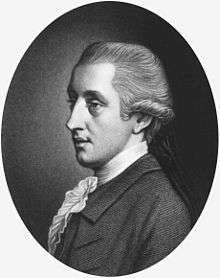William Hewson (surgeon)
| William Hewson | |
|---|---|
 | |
| Born |
14 November 1739 Hexham |
| Died | 1 May 1774 (aged 34) |
| Nationality | United Kingdom |
| Fields |
Surgery anatomist physiologist |
| Known for | haematology |
| Notable awards | Copley Medal (1769) |
William Hewson (14 November 1739 – 1 May 1774) was an English surgeon, anatomist and physiologist who has sometimes been referred to as the "father of haematology".
Biography
Born in Hexham, Northumberland, Hewson initially studied in 1753 at the Newcastle Infirmary, Newcastle upon Tyne (which later became the Royal Victoria Infirmary) under its founder Richard Lambert and much later in the winter of 1761/1762 in Edinburgh and was a student, and later an assistant, of William Hunter. He was awarded the Copley Medal in 1769 and elected to the Royal Society in 1770.[1]
His major contribution was in isolating fibrin, a key protein in the blood coagulation process. His Copley work came when he showed the existence of lymph vessels in animals and explained their function by hypothesizing the existence of a human lymphatic system. He also demonstrated that red blood cells were discoid, rather than spherical as had been previously supposed by Anton van Leeuwenhoek, but incorrectly identified the cells' dark centers as their nuclei. In 1773 he produced evidence for the concept of a cell membrane in red blood cells — however, this last work was largely ignored.
On 10 July 1770 he married Mary Stevenson (better known as Polly), a London friend of Benjamin Franklin. From September 1772 he ran an anatomy school at 36 Craven Street, where Franklin lodged in London (which is now the Benjamin Franklin House museum).
In 1998, workmen restoring the London home (Benjamin Franklin House) dug up the remains of six children and four adults hidden below the home. The Times reported on 11 February 1998:
Initial estimates are that the bones are about 200 years old and were buried at the time Franklin was living in the house, which was his home from 1757 to 1762 and from 1764 to 1775. Most of the bones show signs of having been dissected, sawn or cut. One skull has been drilled with several holes. Paul Knapman, the Westminster Coroner, said yesterday: "I cannot totally discount the possibility of a crime. There is still a possibility that I may have to hold an inquest."
The Friends of Benjamin Franklin House (the organization responsible for the restoration of Franklin's house at 36 Craven Street in London) note that the bones were likely placed there by Hewson, who lived in the house for two years. They note that Franklin likely knew what Hewson was doing.[2] Proof was demonstrated by archaeological evidence which showed liquid mercury associated with turtle bones and vermilion colouring associated with dog bones found in the deposit. Hewson had documented experimentation on the lymphatic system using both substances and animals.[3]
He died on 1 May 1774 as a result of sepsis contracted whilst dissecting a cadaver.
Hewson's work was continued after his death by Magnus Falconar, who had married Hewson's sister Dorothy in September 1774. Falconar repeated Hewson's experiments on the spleen and thymus and as a result re-published Hewson's work on red blood cells in 1777 together with his corroboration.
References
- ↑ "Library and Archive Catalogue". Royal Society. Retrieved 18 November 2010.
- ↑ Newsletter of the friends of Benjamin Franklin House, Issue 2, Autumn 1998. benjaminfranklinhouse.org
- ↑ Simon Hillson, Tony Waldron, Brian Owen-Smith, and Louise Martin, "[www.ai-journal.com/article/download/ai.0206/241 Benjamin Franklin, William Hewson and the Craven Street bones]", Archaeology International, February 2006
Further reading
- "William Hewson". Encyclopædia Britannica Online. Retrieved 2008-02-25.
- Kleinzeller, A. (July 1996). "William Hewson's studies of red blood corpuscles and the evolving concept of a cell membrane.". The American journal of physiology. American Journal of Physiology. 271 (1 Pt 1): C1–8. PMID 8760026.
- 'William Hewson (1739–74): the father of haematology', article in the British Journal of Haematology, May 2006
External links
- 'Bradford Collection' page of the American Philosophical Society
- http://www.rcpe.ac.uk/library/exhibitions/blood_types/blood_types.php
- Article by William Demeshek about Hewson (PDF).
- http://www.pbs.org/wnet/redgold/innovators/bio_hewson.html
- Newcastle Infirmary time-line
- Ben Franklin’s Bones, a "Secrets of the Dead" PBS documentary, premiere date Jan. 28, 2015
 Lee, Sidney, ed. (1891). "Hewson, William (1739-1774)". Dictionary of National Biography. 26. London: Smith, Elder & Co. pp. 312–313.
Lee, Sidney, ed. (1891). "Hewson, William (1739-1774)". Dictionary of National Biography. 26. London: Smith, Elder & Co. pp. 312–313.